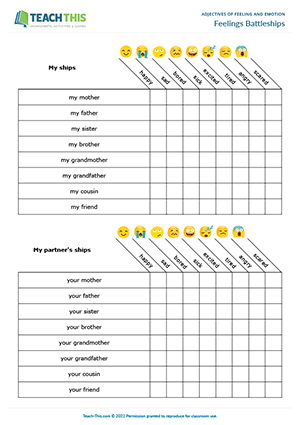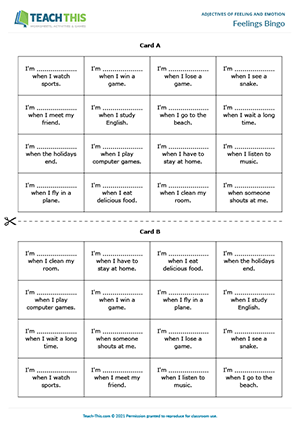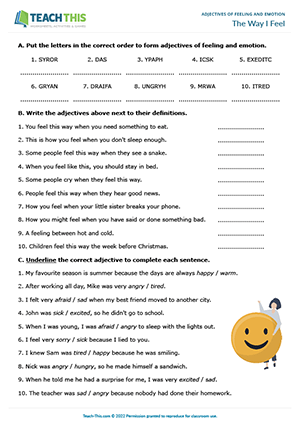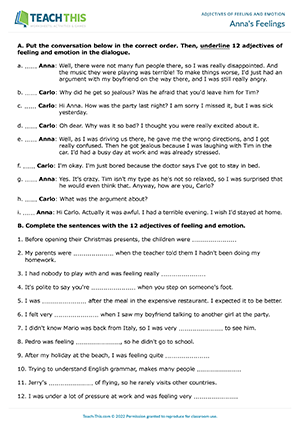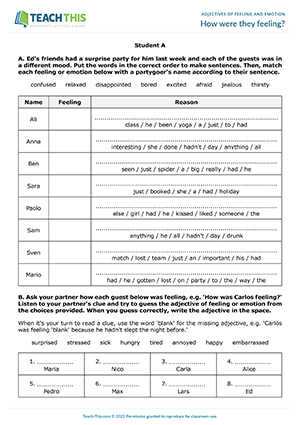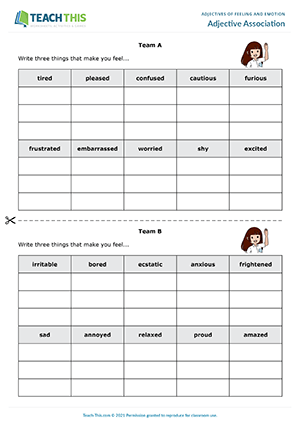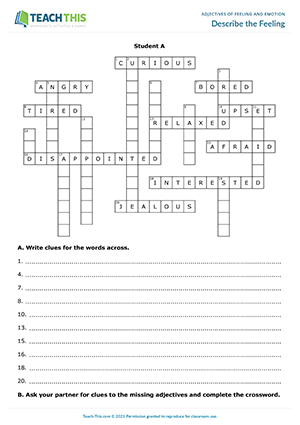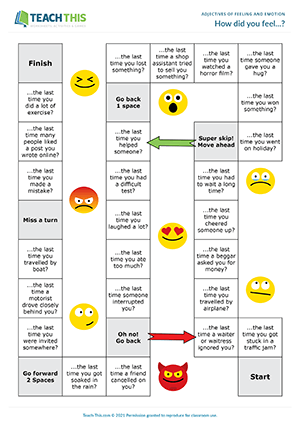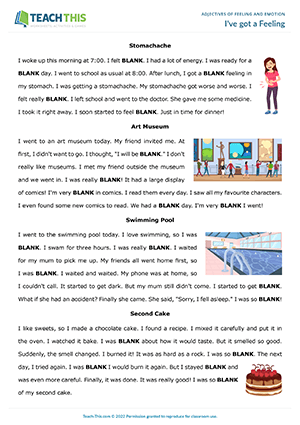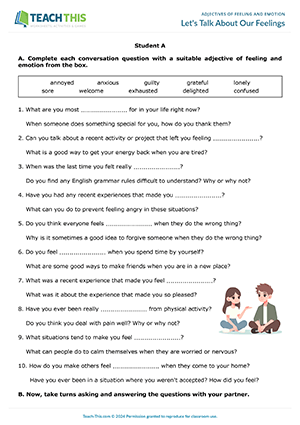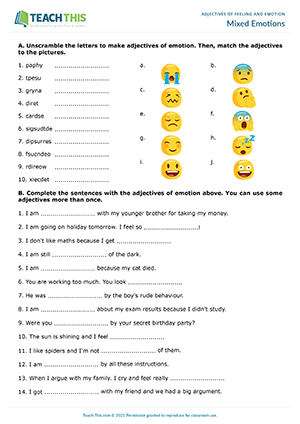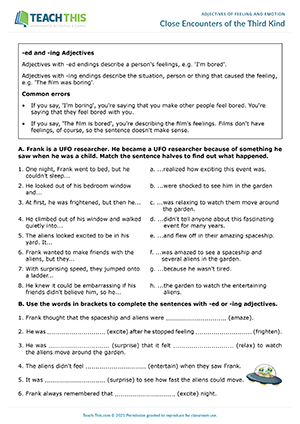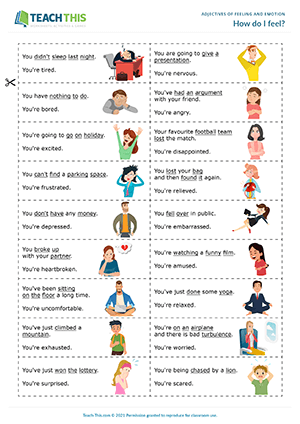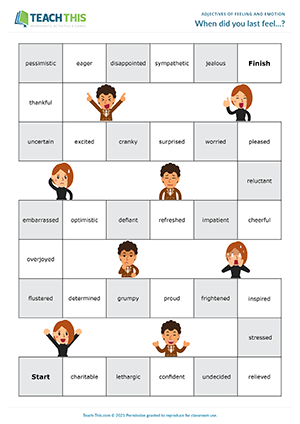In this free adjectives of feeling and emotion game, students play battleships using family vocabulary and adjectives of feeling and emotion. In pairs, students start by marking four ships on their 'My ships' grid. Students then take it in turns to choose a square on their 'My partner's ships' grid. However, instead of giving a grid reference to find a ship, the student makes a yes/no question using the corresponding family vocabulary and adjective of feeling or emotion, e.g. 'Is your mother happy?' Their partner listens to the question, looks at their 'My ships' grid and answers according to whether it is a hit or miss. If it is a hit, their partner replies 'yes', e.g. 'Yes, she is'. If it is a miss, their partner replies 'no', e.g. 'No, she isn't'. The student then marks the square with an 'H' for hit or 'X' for miss. The first student to sink all their partner's ships wins the game.
In this imaginative adjectives of feeling game, students play bingo by making true sentences about how they feel in certain situations. Students take it in turns to roll the feelings dice. The feelings dice shows the adjectives: happy, sad, scared, bored, angry and excited. Students look at the sentences on their bingo card and write the feeling shown on the dice in one of the sentences, making the sentence true for them. For example, if the feeling shown on the dice was 'excited', a student who likes sports might write the adjective in the following sentence: I feel excited when I watch sports. After each student has written the adjective in a suitable sentence, they read their sentence aloud to the group to show it is true. If a student cannot truthfully write the adjective in any sentence, they write nothing for that round. The first student to get four squares in a row wins and shouts 'bingo'.
In this useful feelings and emotions worksheet, students practice common adjectives of feeling and emotion. First, students put letters in the correct order to form adjectives of feeling and emotion. Next, students match the adjectives with their definitions. Students then underline the correct adjective to complete each sentence. After that, students complete sentences with adjectives of feeling and emotion from a box. Following that, students match sentence halves together, adding a suitable adjective to each one. Lastly, students complete each sentence with a feeling or emotion adjective and reason. Students then read each sentence to a partner using the word 'blank' for the adjective. Their partner then tries to guess the adjective that is missing.
In this comprehensive adjectives of feeling and emotion worksheet, students practice 12 common feeling and emotion adjectives. First, students put a conversation in the correct order and then identify 12 adjectives of feeling and emotion in the dialogue. Next, students complete sentences with the adjectives of feeling and emotion and categorise them. After that, students write sentences using adjectives of feeling and emotion. Students then read each sentence to a partner using the word 'blank' instead of the adjective to see if their partner can guess the word. Students then move on to write advice for people who are experiencing two of the negative feelings or emotions. Afterwards, students read out their advice to their partner, without saying the adjective. Their partner then tries to guess what feeling or emotion they are giving advice for. Next, students choose three feelings and complete sentences about the last time they felt each way, making two sentences true and one false. Finally, students read their sentences to their partner and see if they can guess which one is false.
In this enjoyable adjectives of feeling activity, students describe how people were feeling at a party and match the descriptions with feeling and emotion adjectives. In two groups, students unscramble sentences on their worksheet and then match each person at the party with the correct adjective of feeling or emotion according to their sentence. Next, students pair up with someone from the other group and take it in turns to ask each other how the people at the bottom of their worksheet were feeling at the party, e.g. 'How was Carlos feeling?' Their partner then reads the sentence for that person using the word 'blank' for the missing adjective, e.g. 'Carlos was feeling 'blank' because he hadn't slept the night before.' The other student listens to the clue and tries to guess the adjective of feeling or emotion from the choices provided. When the student guesses correctly, they write the adjective in the space.
In this fun adjectives of feeling guessing game, students associate things with adjectives that describe feelings. In teams, students write down three things they associate with the ten adjectives of feeling shown on their worksheet. For example, for three things that make you feel tired, students might write: hard work, no sleep, not eating. Team A then reads out a category at random, e.g. 'Three things that make you feel excited'. Team B has one minute to call out as many answers as they can that they think Team A has associated with the adjective. For each answer that matches with Team A's list, Team B scores one point. When the time limit has been reached, Team B's score is added up and any answers not guessed are revealed by Team A. Team B then calls out a category for Team A to guess and so on. The team with the most points at the end of the game is the winner.
In this rewarding adjectives of feeling and emotion activity, students complete a crossword by describing and guessing feeling and emotion adjectives. In two groups, students invent and write down clues for the adjectives of feeling and emotion written in their crossword. Next, students pair up with someone from the other group and take it in turns to ask their partner for clues to the missing words in their crossword. Their partner reads out the clue for each adjective and the other student tries to guess the word. If the student guesses correctly, they write the word in their crossword. If not, their partner continues to give more clues until the student manages to guess the word. When the students have finished, they check their spellings by comparing crosswords.
In this free adjectives of feeling and emotion board game, students practice describing how they felt the last time certain things happened to them. In pairs, students take it in turns to roll the dice and move their counter along the board. When a student lands on a square, their partner asks them the How did you feel...? question on the square, e.g. 'How did you feel the last time you had a difficult test?' The student then answers the question by describing how they felt the last time the thing happened to them. Their partner then asks the student follow-up questions to continue the conversation and gain more information. The first student to reach the finish wins the game.
In this productive adjectives of feeling and emotion activity, students take part in a running dictation where they dictate short texts and complete missing words with adjectives of feeling and emotion. In pairs, one student is the reader and the other is the writer. The reader runs to the first story, reads the first sentence or two, memorizes it, runs back and dictates it to their partner who writes it down on the worksheet. The writer indicates each missing word by putting a dotted line or leaving a space. This continues until the first story has been fully dictated. The two students then work together to replace the missing words in the text with appropriate adjectives of feeling and emotion from the box on the worksheet. If the adjectives are correct, the two students swap roles and move on to the next story. If not, students correct their mistakes. Pairs repeat the process until all four stories have been completed with students changing roles after each story is complete. The first pair to finish wins.
In this adjectives of feeling and emotion speaking activity, students complete, ask and answer conversation questions containing common adjectives of feeling and emotion. First, in two groups, students complete conversation questions with suitable adjectives of feeling and emotion from a box. Students then pair up with someone from the other group and take turns asking the conversation questions to their partner, who responds accordingly. For the first question in each set, students include the corresponding adjective in their response. Afterwards, students share what they found out about their partner with the class.
Here is an insightful adjectives of emotion worksheet for intermediate students. Students begin by unscrambling letters to make adjectives of emotion. Students then match the adjectives to pictures. Next, students complete sentences with the adjectives. Students then move on to use clues to complete a crossword with adjectives of emotion. In the last exercise, students write 'I feel...' sentences with the adjectives of emotion from the worksheet.
In this interesting adjectives of feeling and emotion worksheet, students learn and practice -ed and -ing adjectives that describe feelings and emotions. To start, students match sentence halves together that use -ed and -ing adjectives of feeling and emotion. Students then use words in brackets to complete sentences with -ed or -ing adjectives. Next, students complete extracts with verbs from a box by changing them to -ed or -ing adjectives. In the last exercise, students use the -ed and -ing adjectives of feeling and emotion from the worksheet to write sentences about close encounters.
In this engaging feelings and emotions game, students guess situations and related adjectives that describe feelings and emotions from mimes. Students take it in turns to pick up a card from the pile and mime the first sentence on the card to the group. The first group member to guess the situation and make a sentence using the underlined keywords on the card scores a point. The student with the card then goes on to mime the related adjective. The first student to guess the adjective scores one point. The card is then removed from the game and the next student picks up a card to mime and so on. The student with the most points at the end of the game wins.
In this entertaining adjectives of feeling and emotion board game, students review advanced adjectives of feeling and emotion by playing a board game where they give true or false answers about when they last felt a certain way. Players take it in turns to roll the dice and move their counter along the board. When a player lands on a square, they pick up a true or false card from the pile and look at it, without showing anyone. The group members then ask the player the When did you last feel...? question on the square, e.g. 'When did you last feel charitable?' The player then answers the question by giving either true or false information as indicated on the card. When the player has answered the question, the other students ask follow-up questions to determine if the player is lying or telling the truth and then make their guesses. The player then reveals the answer. The students who guessed correctly each score one point. When a player reaches the finish, the game ends. The student with the most points wins the game..
Latest Free
Resources
- The Bus Stop
Getting Around (B1)
Date Added: 1st of October
- Study Skills Showdown
Study Skills (B2)
Date Added: 10th of September
- Everyday Objects Bingo
Everyday Objects (A1-A2)
Date Added: 25th of August
- Action Verb Races
Actions (A1-A2)
Date Added: 18th of August
- Birthday Basics
Birthdays (A1-A2)
Date Added: 8th of August
Latest Member
Resources
- Casual Greetings
Greetings and Introductions (B2)
Date Added: 22nd of October
- Identifying and Clarifying Problems
Dealing with Problems (B2)
Date Added: 22nd of October
- What if we tried...?
Dealing with Problems (B2)
Date Added: 22nd of October
- Suitable Excuses
Making Excuses (B2)
Date Added: 21st of October
- Superlatives Showdown
Superlatives (A1-A2)
Date Added: 21st of October



